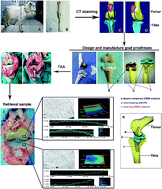Characteristics of wear particles and wear behavior of retrieved PEEK-on-HXLPE total knee implants: a preliminary study†
Abstract
Polyether-ether-ketone (PEEK) has been used clinically for intervertebral fusion and internal fixators in spine and trauma surgery because of its mechanical properties and bioinertness. The present study aimed to assess the suitability of PEEK as an alternative material to cobalt–chromium–molybdenum alloy in total knee arthroplasty (TKA) and evaluate the in vivo wear property on the contact surface of the PEEK-on-highly cross-linked polyethylene (HXLPE). PEEK prosthesis was designed and manufactured using injection molding based on the computed tomography data of a standard goat right hind limb. Fifteen goats underwent TKA using PEEK-on-HXLPE prosthesis on the right hind limb. The goats were sacrificed at 12, 24, and 48 weeks postoperatively. The mean surface roughness (Ra) of the retrieved components, proinflammatory cytokines in the synovial fluid, and characteristics of wear particles in the synovial membrane were investigated using laser confocal microscopy, ELISA and polarized light microscopy. The Ra of the femoral component was about 0.08, 0.1, 0.2, and 0.26 μm at pre-study, 12-, 24-, and 48 weeks in the retrievals, respectively. The Ra of the HXLPE bearing samples was approximately 0.38, 0.4, 0.1, and 0.42 μm at pre-study, 12-, 24-, and 48 weeks in the retrievals, respectively. The median size of the particles was 2.63 μm, 1.98 μm, and 3.00 μm at 12, 24, and 48 weeks, respectively. The particles ranged in size from 0.4 μm to 15 μm, and particles <1 μm accounted for 7–13%, those of size 2–5 μm accounted for 67–76%, and those >5 μm accounted for 11–22%. Levels of interleukin (IL)-6, IL-10, and tumor necrosis factor-α (TNF-α) were significantly increased in synovial fluids at 24- and 48 weeks after surgery. Wear occurred on the surfaces of the PEEK and HXLPE material and the size of most wear particles was 1–5 μm. This induced an inflammatory response in the synovial membrane and release of proinflammatory cytokines. A high polishing process may be necessary to lengthen the life of the PEEK prosthesis by reducing the wear and the generation of debris. The PEEK prosthesis as a new generation of artificial joints is promising to be used clinically in the future.



 Please wait while we load your content...
Please wait while we load your content...